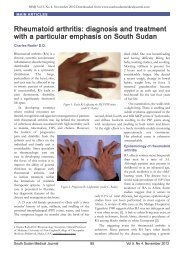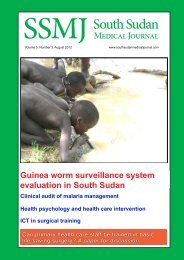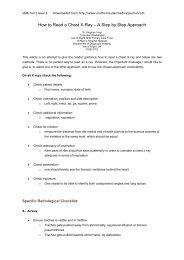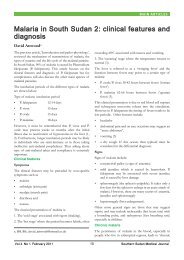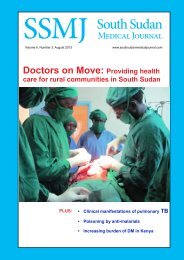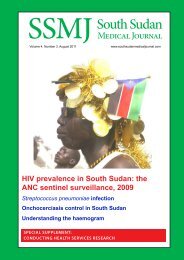Tuberculosis 1. Epidemiology of mycobacterium tuberculosis
Tuberculosis 1. Epidemiology of mycobacterium tuberculosis
Tuberculosis 1. Epidemiology of mycobacterium tuberculosis
Create successful ePaper yourself
Turn your PDF publications into a flip-book with our unique Google optimized e-Paper software.
RESEARCHSSMJ Vol 5. No 2. May 2012 Downloaded from www.southsudanmedicaljournal.comhigher than for those with normal immune systems.Generally, persons at high risk for developing TB diseasefall into two categories (7):<strong>1.</strong> Persons who have been recently infected with TBbacteria.2. Persons with medical conditions that weaken theimmune system.<strong>1.</strong> Persons who have been recently infected with TBbacteriaThese include:• Persons who have close contacts with a person withinfectious TB disease.• Persons who have immigrated from areas <strong>of</strong> theworld with high rates <strong>of</strong> TB.• Children less than 5 years <strong>of</strong> age who have a positiveTB test.• Persons from groups with high rates <strong>of</strong> TBtransmission, such as homeless persons, injectiondrug users, and persons with HIV infection.• Persons who work or reside with people who are athigh risk <strong>of</strong> TB in facilities or institutions such ashospitals, homeless shelters, correctional facilities,nursing homes and residential homes for those withHIV.2. Persons with medical conditions that weaken theimmune systemBabies and young children <strong>of</strong>ten have weak immunesystems. Other people can have weak immune systemsespecially those with any <strong>of</strong> these conditions:• HIV infection.• Substance abuse.• Silicosis (8).• Diabetes mellitus.• Severe kidney disease.• Low body weight.• Organ transplants.• Head and neck cancer.• Medical treatments such as corticosteroids or organtransplant.• Specialized treatment for rheumatoid arthritis orCohn’s disease.In South Sudan although the exact incidence <strong>of</strong> HIV/AIDS among TB cases is not known, HIV prevalenceappears to be on the rise. Data from limited populationsurveys show HIV prevalence rates range between 1 and8 percent among the general population, with higher rates(up to 25 percent) found in border towns. Multidrugresistant(MDR) TB cases account for around <strong>1.</strong>9 percent<strong>of</strong> new cases and usually occurs among defaulters andrelapse cases.The TB epidemic is an outgrowth <strong>of</strong> a long-standingwar, which has resulted in poverty, malnutrition, and alarge number <strong>of</strong> displaced populations and refugees.Destruction <strong>of</strong> health infrastructure, lack <strong>of</strong> microscopicservices, and displacement or lack <strong>of</strong> health personnelhave also contributed to the epidemic (3).References:<strong>1.</strong> deJong BC, Antonio M, Gagneux S. Mycobacteriumafricanum: review <strong>of</strong> an important cause <strong>of</strong> human<strong>tuberculosis</strong> in West Africa. PLoS Negl Trop Dis 2010;4:e744.2. Cole ST, Brosch R, Parkhill J, et al. Deciphering the biology<strong>of</strong> Mycobacterium <strong>tuberculosis</strong> from the complete genomesequence. Nature 1998; 393:537.3. USAID Health: Infectious Diseases, <strong>Tuberculosis</strong>,Countries, Sudan. Available on line at: http://www.usaid.gov/our_work/global_health/id/<strong>tuberculosis</strong>/countries/africa/ssudan_pr<strong>of</strong>ile.html4. Corbett EL, Marston B, Churchyard GJ, De Cock KM.<strong>Tuberculosis</strong> in sub-Saharan Africa: opportunities,challenges, and change in the era <strong>of</strong> antiretroviral treatment.Lancet 2006; 367:926.5. Wright A, Zignol M, Van Deun A, et al. <strong>Epidemiology</strong><strong>of</strong> anti<strong>tuberculosis</strong> drug resistance 2002-07: an updatedanalysis <strong>of</strong> the Global Project on Anti-<strong>Tuberculosis</strong> DrugResistance Surveillance. Lancet 2009 Apr 15.6. Centers for Disease Control and Prevention. TB Basicfacts. CDC/TB/Basic TB Facts. Available on line at http://www.cdc.gov/tb/topic/basics/default.htm7. Centers for Disease Control and Prevention. TB Basicfacts. CDC/TB/Basic TB Facts/Risk Factors. Available online at http://www.cdc.gov/tb/topic/basics/risk.htm8. Huaux F. New developments in the understanding <strong>of</strong>immunology in silicosis. Current Opinion in Allergy & ClinicalImmunology: 2007: 7 (2):168-173.South Sudan Medical Journal 46Vol 5. No 2. May 2012




